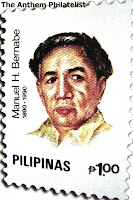Gregorio del Pilar on Stamps

Already a general at age 25, Gregorio del Pilar was known as the "boy general" in the revolutionary army directly under the command of Gen. Antonio Luna. He cut a dashing figure with his silver spurs and khaki suit with gold shoulder straps. He led Gen. Emilio Aguinaldo's rear guard as Aguinaldo retreated towards the mountain province. Del Pilar fought a delaying battle against the approaching American Army and died defending the Tirad Pass in La Union.
Born on November 14, 1875 to Fernando H. del Pilar and Felipa Sempio of Bulacan, Bulacan, del Pilar was the nephew of propagandist Marcelo H. del Pilar and Toribio H. del Pilar, who was exiled to Guam for his involvement in the 1872 Cavite Mutiny.
"Goryo", as he was casually known, studied at the Ateneo Municipal de Manila, where he received his Bachelor’s degree in 1896, at the age of 20. When the Philippine Revolution against Spanish rule broke out in August under the leadership of Andres Bonifacio, del Pilar joined the insurgency. He distinguished himself as a field commander while fighting Spanish garrisons in Bulacan.
He later joined General Emilio Aguinaldo, who had gained control of the movement, in Hong Kong after the truce at Biak-na-Bato. During the Spanish American War, Aguinaldo returned to the Philippines and established the government of the First Philippine Republic. He appointed del Pilar section leader of the revolutionary forces in Bulacan and Nueva Ecija. On June 1, del Pilar landed in Bulacan with rifles purchased in Hong Kong, quickly laying siege on the Spanish forces in the province. When the Spaniards surrendered to del Pilar, he brought his men to Caloocan, Manila to support the other troops battling the Spaniards there.
When the Philippine-American War broke-out on February 1899, del Pilar led his troops to a short victory over Major Franklin Bell in the first phase of the Battle of Quingua on April 23, 1899, in which his forces repelled a cavalry charge and killed the highly respected Colonel John M. Stotsenburg, after whom Clark Air Base was originally named (Fort Stotsenburg).
On December 2, 1899, del Pilar led 60 Filipino soldiers of Aguinaldo's rear guard in the Battle of Tirad Pass against the "Texas Regiment", the 33rd Infantry Regiment of the United States led by Peyton C. March. A delaying action to cover Aguinaldo's retreat, the five-hour standoff resulted in Del Pilar's death due to a shot to the neck (at the height or end of the fighting, depending on eyewitness accounts). Del Pilar's body was later despoiled and looted by the victorious American soldiers.
Del Pilar's body lay unburied for days, exposed to the elements. While retracing the trail, an American officer, Lt. Dennis P. Quinlan, gave the body a traditional U.S. military burial. Upon del Pilar's tombstone, Quinlan inscribed, "An Officer and a Gentleman".
In 1930, del Pilar's body was exhumed and was identified by the gold tooth and braces he had installed while in exile in Hong Kong.
The stamp was issued on September 18, 1981.






